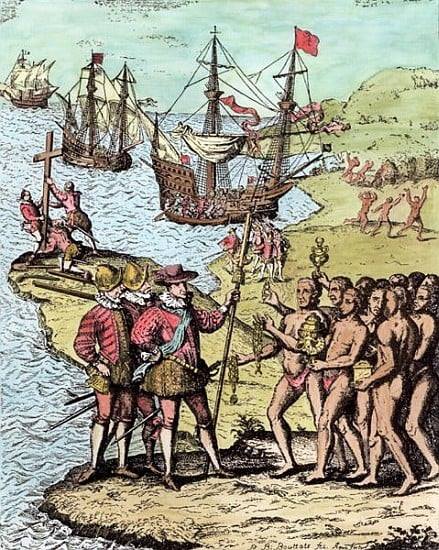In movies, books and paintings, we've all absorbed the scene of Columbus, or John Cabot or another European ship captain with his armed thugs, sometimes with a priest, planting a flag or banner, and making a proclamation. In many cases, they had little idea about where they were--the northern buffer regions of Cathay? Japan? If they ran into the people who lived there, they didn't understand the languages, even as they read something aloud.
So what were they doing? It was a proclaiming of the 'Doctrine of Discovery' based on a set of three 'Bulls' issued by the Pope in Rome that made the land and peoples they were standing on now under the ownership and sovereignty of whatever kingdom who financed them. They only had to know two, maybe three, things. 1. The native peoples were heathen; 2. They were previously unknown in Europe; and 3. they were not part of a class-divided social order, subject to kings or princes of their own. Since the last one was hard to determine, it was often ignored.
What was the reason for this 'Doctrine?' In the early 1400s, the Islamic world was making it hard for the kingdoms of Christendom to trade with the far east via the Silk Road, the Red Sea and other routes. The pressure was on to find new trade routes. Henry the Navigator went to work for the Portuguese king, taking over the Canaries, working his way down the African coast, finding gold and ivory, and finally making it around the Cape into the Indian Ocean. Columbus, on the other hand, started claiming islands beyond the Azores for Spain. So Spain and Portugal clashed, and took it to the pope. To shorten the tale, his Holiness drew a line down the middle of the Atlantic--everything to the West was Spain's, to the east, Portugal's. That's why Brazil largely speaks Portuguese.
But what about the rest of the Kingdoms of Europe? Were they cut out? No, there was a loophole. They could claim lands 'unknown' to Portugal or Spain. An early rival was John Cabot, working for English merchants with some help from Henry the VII. His first trip failed to make it, but the second, around 1497, got him to what most think is Newfoundland. He got on the beach, planted the English banner, read his little speech, walked around for about 100 yards, found a vacated native campsite, then got back on the ship and headed home. He corresponded with Columbus, comparing notes, and correctly concluding that 'Turtle Island' was unknown to Columbus, so bingo, North America now belonged to the English king. Except John Cabot died somewhere on his third voyage, and the new king, Henry VIII, was too busy marrying and divorcing, and breaking with the Pope, to care that much about 'the new found lands.'






No comments:
Post a Comment